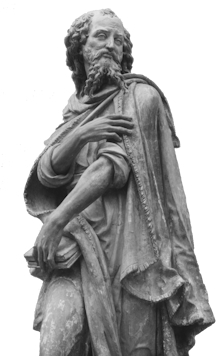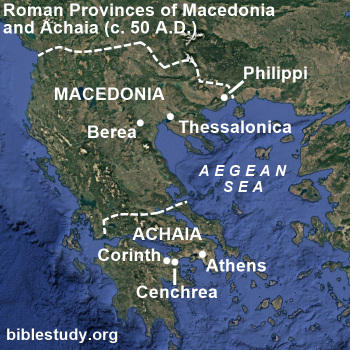Who Traveled with Paul?
The Last Journeys!
Early Travels
Paul, in the summer of 40 A.D. is in his hometown of Tarsus when God begins to call and convert a many people in Syrian Antioch (Acts 11:20 - 21). Barnabas' investigation of what is happening in the city moves him to journey to Tarsus and seeks Paul's help. The pair travel from Tarsus to Antioch where they will spend a year supporting its fast-growing church (Acts 11:25 - 26).
Barnabas and Paul, in the spring of 44 A.D., escort needed food relief from Syrian Antioch to Judea due to a prophesied famine (Acts 11:27 - 30). After their delivery is completed they travel back to the city with Mark in tow (Acts 12:25).
First Missionary Journey
Paul's first missionary journey starts in Syrian Antioch in the late spring of 44 A.D. (Acts 13:4 - 14:25). Accompanying him on his travels is Barnabas and Mark. The group sails to the island of Cyprus and evangelizes it before taking a ship to the Asia Minor port of Perga.

It is in Perga that Mark refuses to travel further and leaves for Jerusalem (Acts 13:13). Paul and Barnabas complete the remaining part of the missionary journey by preaching in the regions of Phrygia and Galatia before going back to Perga. They eventually arrive back in Antioch.
The Jerusalem Conference
In late summer of 49 A.D. Barnabas, Paul, Titus (Galatians 2:1), along with others who are not named (Acts 15:2), travel from Syrian Antioch to Jerusalem. The purpose of the journey is to settle, along with the apostles and the brethren, the controversy over whether Gentile converts need to be circumcised (Acts 15). The discussion and debate on this issue is known as the Jerusalem conference.
After the conference reaches its conclusion it composes a letter and sends it to Antioch accompanied by Paul, Barnabas, Judas (Barsabas) and Silas (Acts 15:22).
The Second Missionary Journey
Paul and Silas leave Syrian Antioch to start the apostle's second missionary journey (Acts 15:40 - 41). Their travels will first take them west to visit the cities of Derbe, Lystra and Iconium.
It is in Lystra that Paul meets a young man named Timothy who will join the evangelistic team. He will become a frequent traveling companion and his closest friend (Acts 16:1 - 3).
When the three men (Paul, Silas and Timothy) arrive in Troas they meet Luke (likely for the first time) before making their way to the European continent. Luke, the writer of the book of Acts, subtlely reveals his presence by using the word "they" in Acts 16:4, 6 - 8 but using "we" in verse 10!
Now when THEY had passed by Mysia, THEY came to Troas . . .
And after he (Paul) had seen the vision, WE immediately sought to go into Macedonia (from Troas) . . . (Acts 16:8, 10, HBFV throughout).
Staying in Philippi
The now four man evangelistic team (Paul, Silas, Timothy and Luke) sail to Neapolis and travel to Philippi. Luke then stays in Philippi which he denotes by using the word "they" to record those who left the city for Amphipolis and Apollonia (Acts 17:1).

Timothy also stays a short time in Philippi to help the city's new Christian church (Life and Epistles of St. Paul, chapter 9). Only Paul and Silas are mentioned traveling west to Thessalonica to preach the gospel (see Acts 17:4).
Timothy eventually meets back up with Paul and Silas likely in Berea, as Scripture only mentions the two men leaving Thessalonica (Acts 17:10). It is then clear from the Bible that Silas and Timothy stayed in Berea for a time while the apostle traveled with other unnamed brethren to Athens.
Then the brethren (in Berea) immediately sent Paul away, as if he were going to the sea; but both Silas and Timothy remained there.
Now those who were conducting Paul brought him to Athens; and after receiving Paul’s command to Silas and Timothy to come to him as quickly as possible, they departed (Acts 17:14 - 15).
Alone in Athens
While Paul is alone in Athens he requests Timothy and Silas, who are in Berea, to travel immediately to him (Acts 17:15). Timothy arrives in Athens and is quickly sent back to Macedonia to check on the new church in Thessalonica (1Thessalonians 3:1 - 5).
It is unclear, however, at this point of the second missionary journey, what happened to Silas. Paul does not mention him when Timothy comes to Athens (1Thessalonians 3:1 - 5). One possibility is that Silas was indeed with Timothy and was also sent back to check on either the church at Thessalonica or another one in Macedonia. Another possibility is that Silas ended up staying in Macedonia when Timothy left for Athens and was still there when Timothy came back.
What is Biblically known for certain is that both Silas and Timothy, who traveled from Macedonia, met the apostle in Corinth after he had left Athens.
Now when Silas and Timothy came down from Macedonia (to Corinth, see Acts 18:1), Paul was stirred in his spirit and was earnestly testifying to the Jews that Jesus was the Christ (Acts 18:5).
While staying in Corinth the Apostle Paul meets a couple, Priscilla and Aquila, who share the same talent for making tents (Acts 18:2 - 3).
Leaving Corinth
When Paul leaves Corinth in the autumn 52 A.D. he leaves with Aquila and Priscilla and journeys to Cenchrea. They then sail to Ephesus (Acts 18:18 - 19). The apostle, after only a short stay, leaves Ephesus alone and travels to Jerusalem (verse 21).
Who Were They?
Who traveled with the Apostle Paul on his early journeys? Companions on these trips included Aquila, Barnabas, Judas (Barsabas), Luke, Mark, Priscilla, Silas, Timothy and Titus. There were also unnamed brethren who accompanied the apostle to Jerusalem (Acts 15:2). Additionally, an unknown number of brethren escorted him to Athens during his second missionary journey (Acts 17:14 - 15).